Table of Contents
- Introduction
- Editor’s Choice
- Global Multi-Factor Authentication Market Overview
- Password Security Issues Driving the Demand for MFA
- MFA Adoption Statistics
- Commonly Used MFA Methods
- Multi-Factor Authentication Usage in Organizations
- Latest Multi-Factor Authentication Trends
- Multi-Factor Authentication Challenges
Introduction
According to Multi-factor Authentication Statistics, Multi-factor authentication (MFA) is an essential security measure that strengthens access control by insisting that users provide at least two types of authentication, like passwords and mobile codes. It plays a critical role in safeguarding digital information in our interconnected world, enhancing security by reducing vulnerabilities associated with single-factor authentication and preventing unauthorized access attempts.
While it offers advantages such as improved security and compliance, successful implementation requires a careful balance between security and user convenience, as well as addressing potential challenges. In summary, MFA is a central component of today’s cybersecurity landscape, serving as a protective barrier against unauthorized access and data breaches.
Editor’s Choice
- In 2023, the Multi-Factor Authentication market generated USD 14.4 billion in revenue.
- Large enterprises dominate the enterprise landscape, holding a substantial 64% market share. These organizations, often with extensive resources and complex security needs, are at the forefront of adopting MFA solutions to safeguard their digital assets and sensitive information.
- As per findings from LastPass, in 2019, MFA usage in businesses globally saw a notable uptick, with 57% of them incorporating it into their security practices, marking a 12% increase from the preceding year.
- According to the Okta Secure Sign-In Trends Report, push notifications emerged as the most commonly employed MFA method, followed by SMS notifications and soft tokens.
- Notably, the technology sector led the way in MFA and 2FA adoption, with a robust 87% of organizations implementing these security measures.
- In 2021, the worldwide landscape of Multi-Factor Authentication (MFA) methods saw notable preferences among users, with smartphone-based authentication emerging as the most convenient choice, commanding a significant 73% usage rate.
- When it comes to MFA usage among employees, a substantial 95% opt for software-based solutions, predominantly mobile apps.
Global Multi-Factor Authentication Market Overview
Global Multi-Factor Authentication Market Size
- The global Multi-Factor Authentication (MFA) market has been experiencing significant revenue growth over the past decade at a CAGR of 15.2%.
- In 2022, the market generated USD 12.5 billion in revenue, and this upward trajectory is expected to continue.
- In 2023, the revenue increased to USD 14.4 billion, followed by a further rise to USD 16.3 billion in 2024.
- Looking ahead to 2030 and beyond, the MFA market is poised for substantial growth, with revenue projections of USD 36.8 billion in 2030, USD 42.4 billion in 2031, and an impressive USD 49.7 billion in 2032.
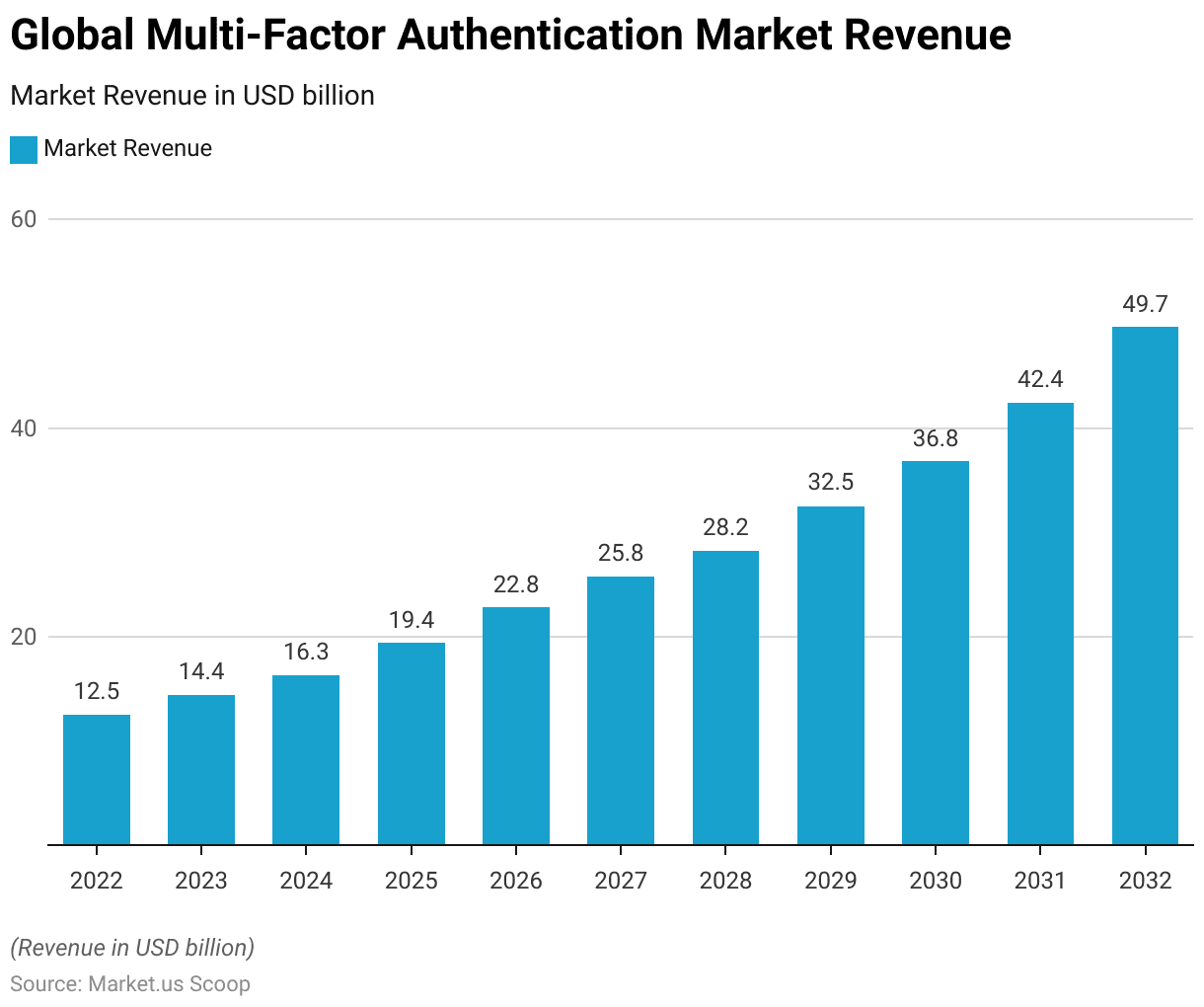
Multi-Factor Authentication Market Size – By Authentication Type
- The Global Multi-Factor Authentication (MFA) market exhibits a robust growth trajectory, with a focus on different authentication types, namely Password Authentication and Password-less Authentication.
- In 2022, the total MFA market revenue stood at USD 12.5 billion. Within this, Password Authentication accounted for USD 7.3 billion, while Password-less Authentication contributed USD 5.3 billion.
- The trend continues with revenue figures of USD 16.3 billion for the total MFA market in 2024, comprising USD 9.5 billion from Password Authentication and USD 6.8 billion from Password-less Authentication.
- This growth pattern persists, with revenue estimates projecting the total MFA market to reach USD 49.7 billion in 2032, of which Password Authentication is expected to contribute USD 28.8 billion, and Password-less Authentication is set to reach USD 20.9 billion.

Global Multi-Factor Authentication Market Share – By Enterprise Size
- In the Global Multi-Factor Authentication (MFA) market, the distribution of market share varies significantly based on the size of enterprises.
- Large enterprises dominate this landscape, holding a substantial 64% market share. These organizations, often with extensive resources and complex security needs, are at the forefront of adopting MFA solutions to safeguard their digital assets and sensitive information.
- On the other hand, small enterprises also play a significant role, accounting for 36% of the market share. Despite their relatively smaller size, these businesses recognize the importance of robust security measures provided by MFA to protect their operations from potential threats.
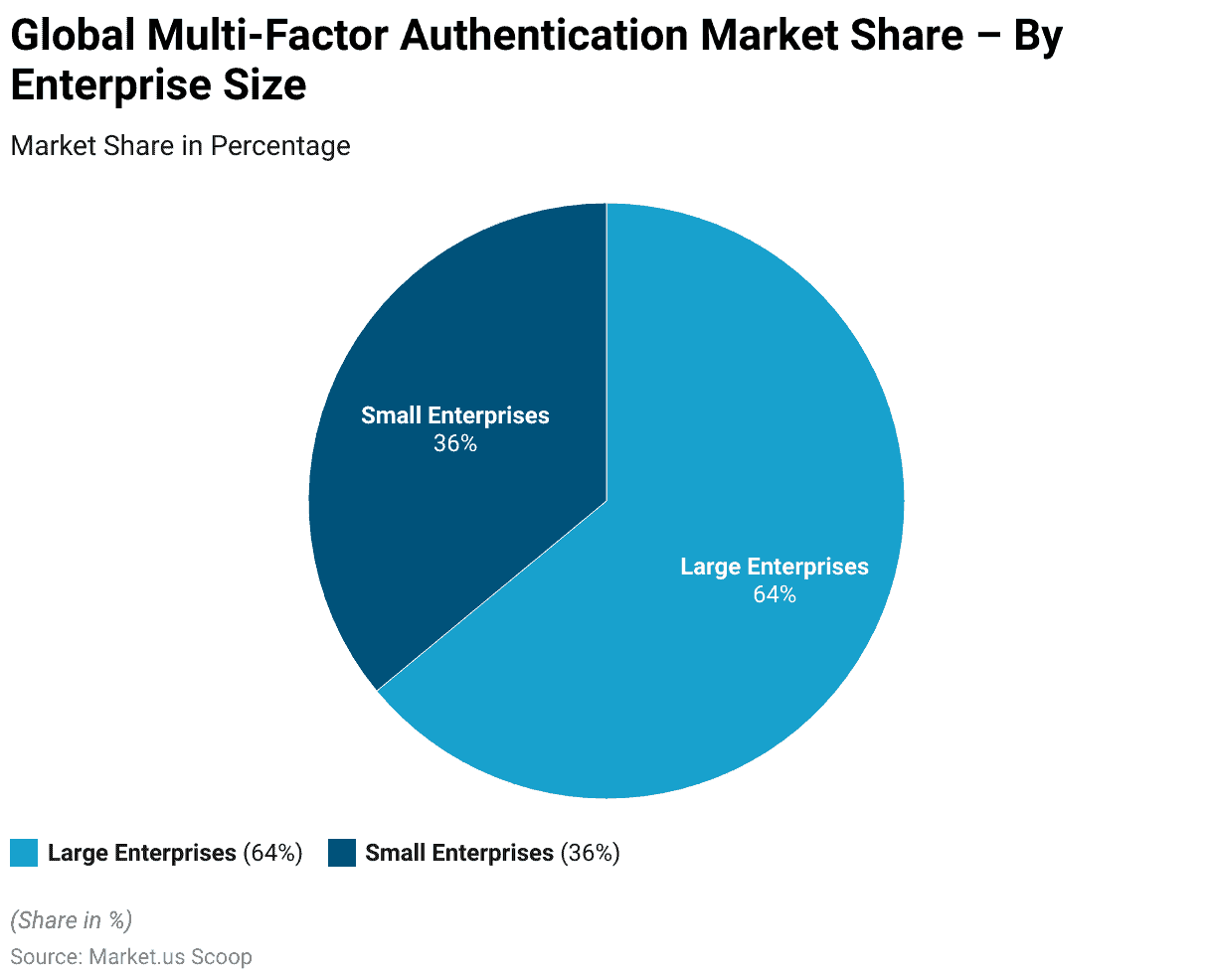
Password Security Issues Driving the Demand for MFA
- The Workplace Password Malpractice Report highlights a troubling pattern in password security, underscoring the urgent need for stronger measures.
- It reveals that many people continue to use overly simple and easily guessable passwords like “123456,” “123456789,” “qwerty,” “password,” and “12345,” which poses a significant security risk.
- The study also unveils that 57% of individuals resort to jotting down their passwords on sticky notes, and out of these, 67% confess to losing these notes, thereby increasing the risk of unauthorized access.
- Additionally, 62% of people store passwords in physical notebooks, often left exposed, such as near their work devices.
MFA Adoption Statistics
- As per findings from LastPass, in 2019, MFA usage in businesses globally saw a notable uptick, with 57% of them incorporating it into their security practices, marking a 12% increase from the preceding year.
- Moreover, the adoption of 2FA demonstrated substantial growth, surging by 51% from 2017 to 2021.
- However, according to the Global Small Business Multi-Factor Authentication (MFA) Study by the Cyber Readiness Institute, the scenario among small to medium-sized businesses (SMBs) is less encouraging, with 54% of them not implementing MFA at all, and a mere 28% making it a mandatory security measure.
- Interestingly, Okta’s recent Secure Sign-In Trends Report revealed that, somewhat surprisingly, highly regulated industries and large enterprises exhibited a slower pace in embracing MFA compared to other sectors.
MFA Adoption – By Industry
- The adoption of Multi-Factor Authentication (MFA) varies across different industries, reflecting varying levels of emphasis on cybersecurity.
- In the technology sector, MFA adoption stands at a robust 87%, highlighting the industry’s commitment to safeguarding sensitive data and intellectual property.
- Insurance follows closely behind with a 77% adoption rate, indicating the recognition of the importance of MFA in protecting sensitive customer information and financial data.
- Professional services and education sectors demonstrate significant adoption as well, with adoption rates of 75% and 64%, respectively.
- In the finance and banking industry, where stringent security measures are paramount, MFA adoption reaches 60%.
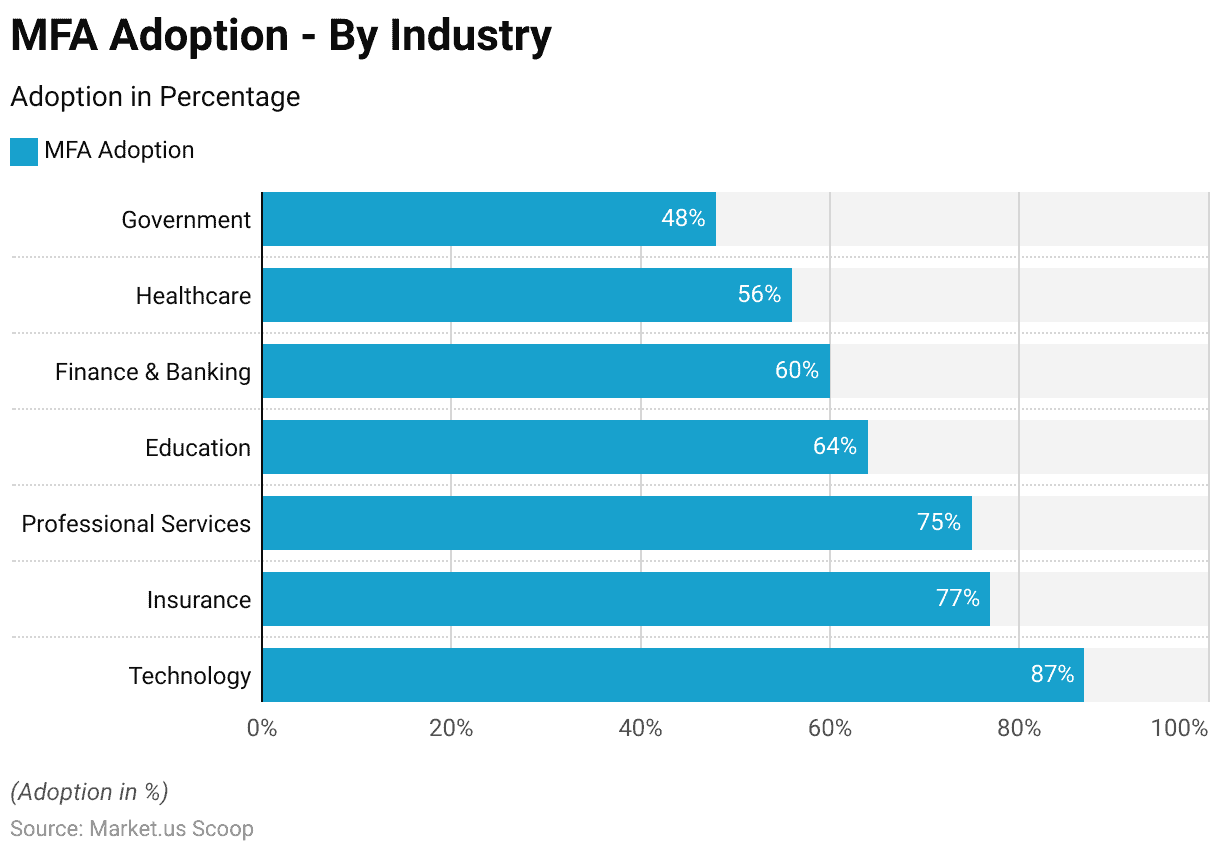
Commonly Used MFA Methods
- In 2021, the worldwide landscape of Multi-Factor Authentication (MFA) methods saw notable preferences among users, with smartphone-based authentication emerging as the most convenient choice, commanding a significant 73% usage rate.
- Leveraging the capabilities of smartphones for authentication purposes offers a seamless and accessible way to enhance security.
- Additionally, built-in authenticators like TouchID and Windows Hello accounted for 17% of MFA adoption, providing users with the convenience of biometric authentication integrated into their devices.
- A smaller yet notable portion of users, constituting 5%, opted for MFA methods involving a smart card or a U2F security key, such as Yubikey.
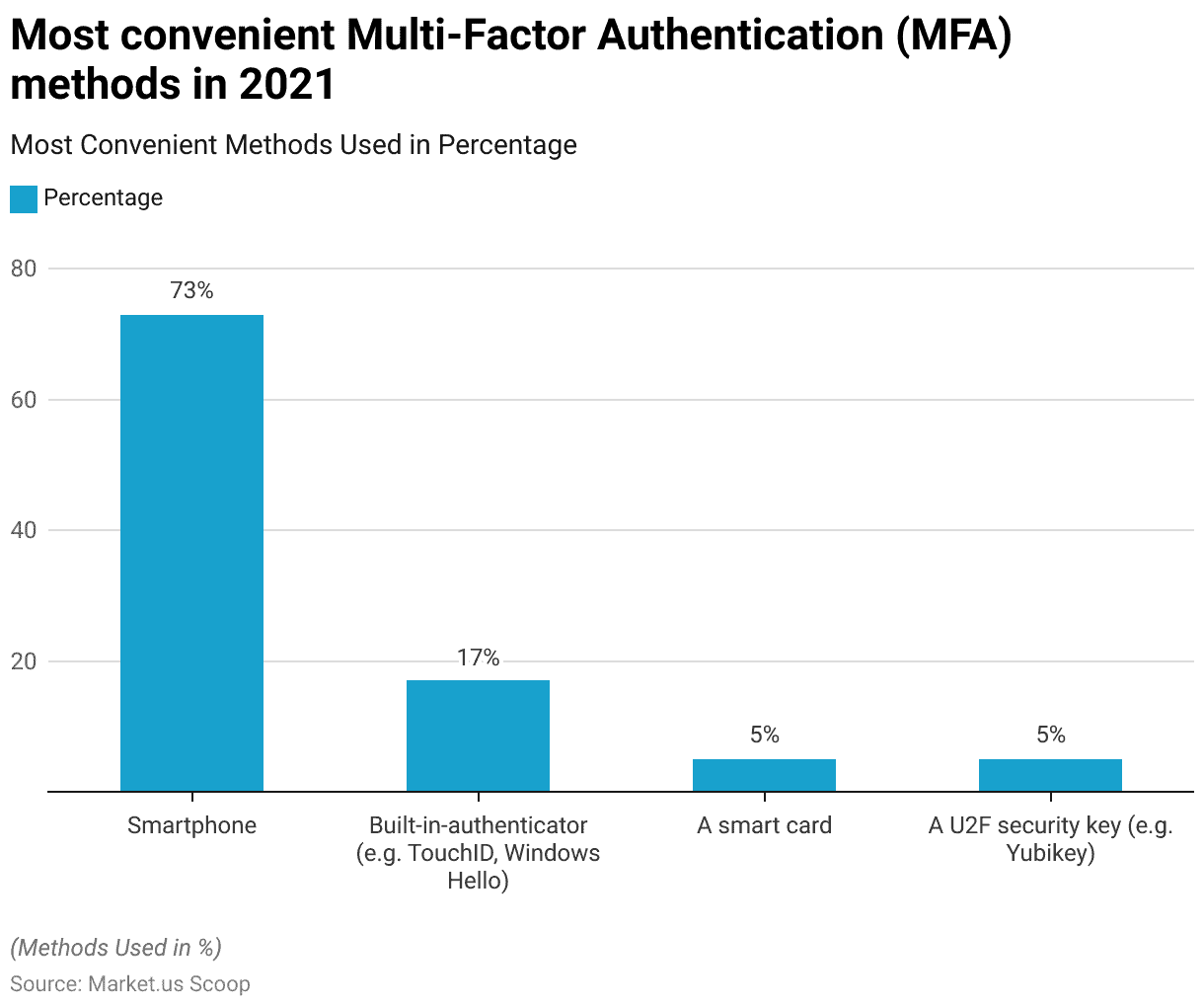
Multi-Factor Authentication Usage in Organizations
- Based on an extensive analysis conducted by LastPass, which encompassed more than 47,000 organizations worldwide utilizing its password management services, it was revealed that 57% of these organizations have embraced multi-factor authentication (MFA). This marks a significant increase of 12% points compared to the previous year’s findings.
- When it comes to MFA usage among employees, a substantial 95% opt for software-based solutions, predominantly mobile apps.
- In contrast, only a mere 4% prefer hardware-based options, and merely 1% rely on biometric methods such as facial or fingerprint recognition.
- Specifically, among employees utilizing MFA with LastPass, the LastPass Authenticator emerged as the preferred choice, with a 39% usage rate.
- Duo Security was the top pick for 31%, while Google Authenticator found favor with 24% of respondents. Additional options included Yubikey (4%) and Microsoft Authentication (1%).
MFA Usage by Companies Worldwide – By Type
- In the global landscape of Multi-Factor Authentication (MFA) usage by companies in 2021, several methods were employed to bolster security measures.
- The most prevalent choice was the use of authenticator applications, representing 57.8% of MFA adoption. These applications offer a versatile and secure means of verifying user identities.
- Following closely, SMS codes were utilized by 39.1% of companies, providing a convenient method for delivering authentication codes to users’ mobile devices.
- One-time passwords (OTP) were also popular, with 37.4% of companies relying on this secure and time-sensitive authentication approach.
- Hardware security keys were employed by 30% of companies, enhancing security through physical devices.
- Additionally, secondary email addresses were utilized by 14.7% of companies as an authentication method.
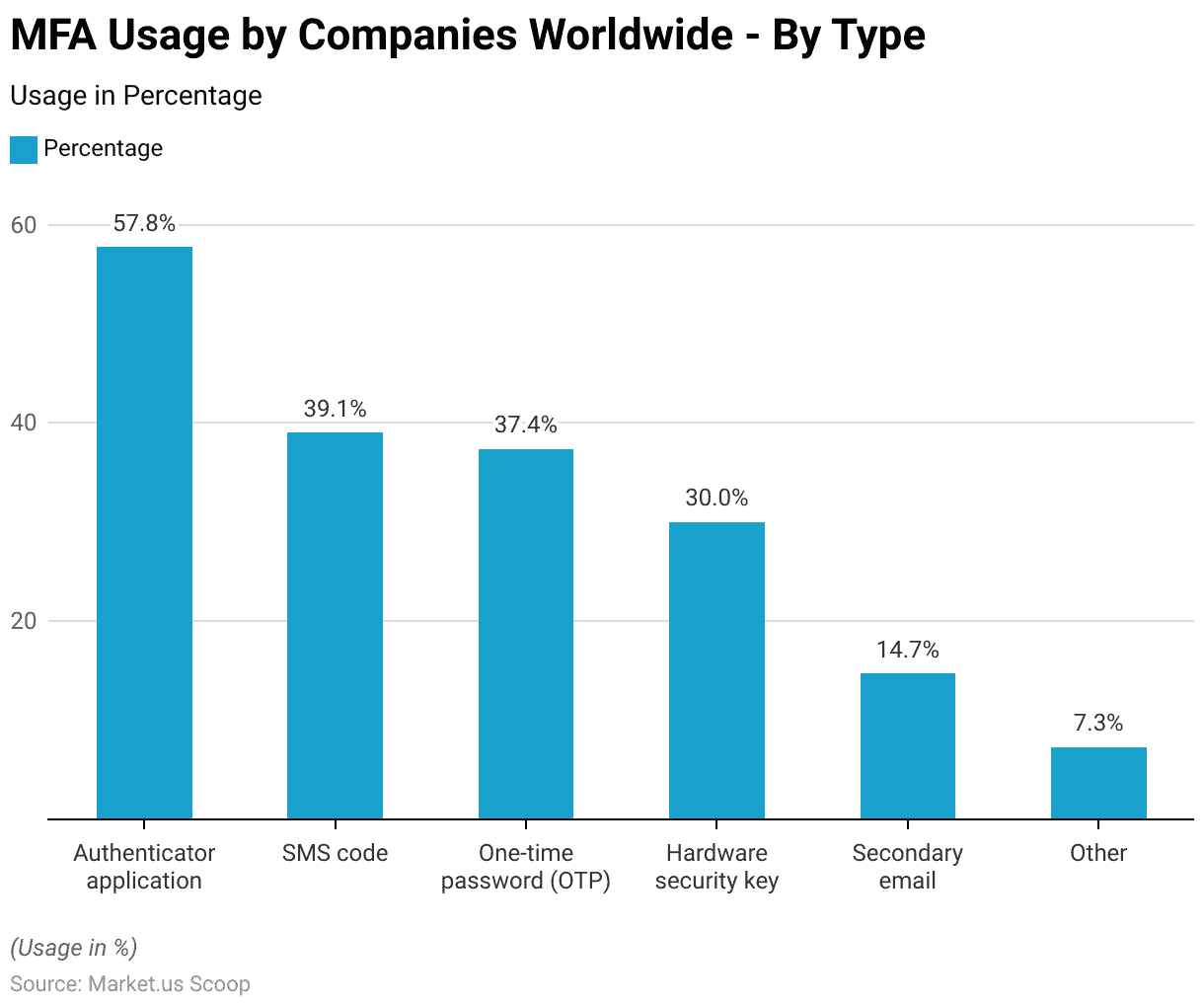
Latest Multi-Factor Authentication Trends
- Microsoft reports that its systems face more than 1,000 password attacks per second, highlighting the relentless nature of cyber threats.
- Importantly, over 99.9% of compromised accounts lack Multi-Factor Authentication (MFA) protection.
- A majority of individuals hold a favorable view of online platforms implementing Multi-Factor Authentication (MFA).
- Among them, 67% in the United Kingdom believe that services embracing MFA demonstrate a commitment to safeguarding personal data.
Multi-Factor Authentication Challenges
- When you’ve implemented multi-factor authentication (MFA) for your accounts, you’ve made a substantial move in securing your online identity.
- While the ultimate aim is to attain full protection, it’s noteworthy that even among the 28% of users who have activated MFA, attackers continue to target them.
- The presence of MFA prompts attackers to devise more advanced methods to bypass this security measure, resulting in the development of more sophisticated attack techniques.
Discuss your needs with our analyst
Please share your requirements with more details so our analyst can check if they can solve your problem(s)



